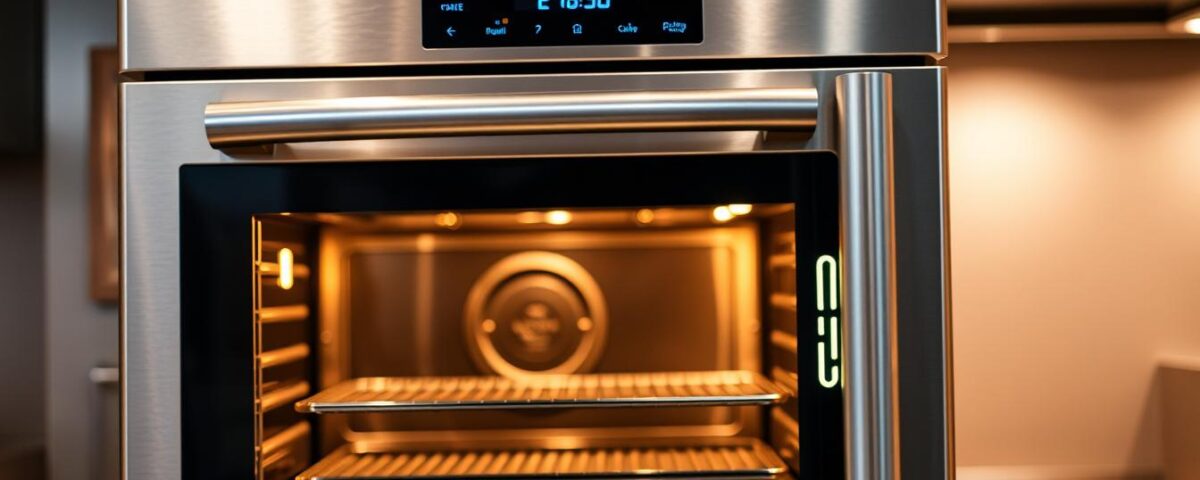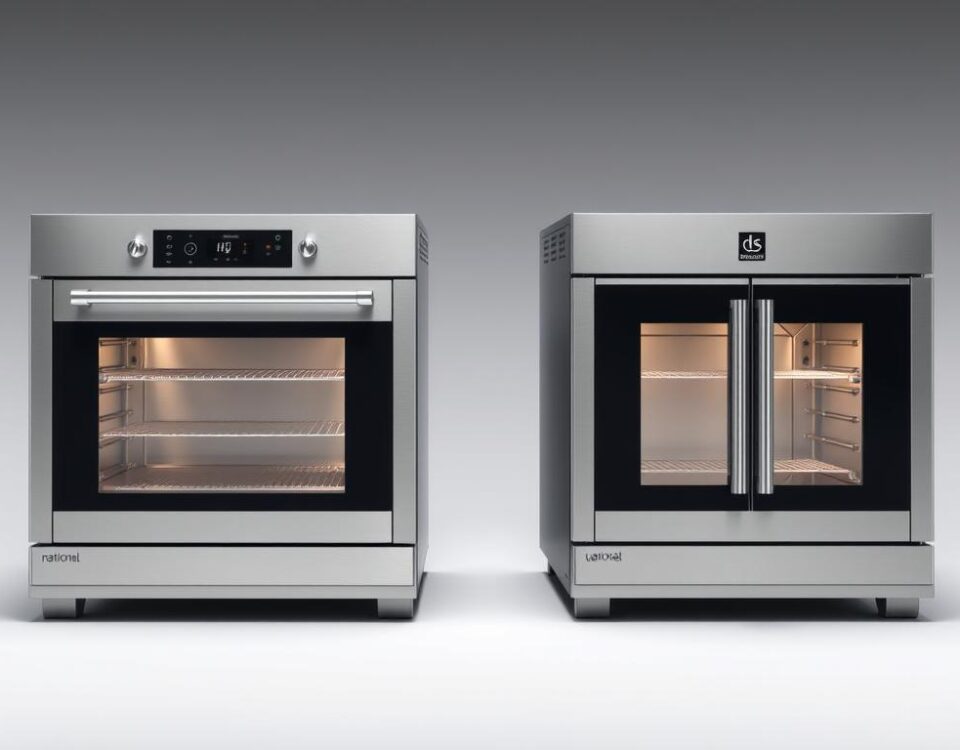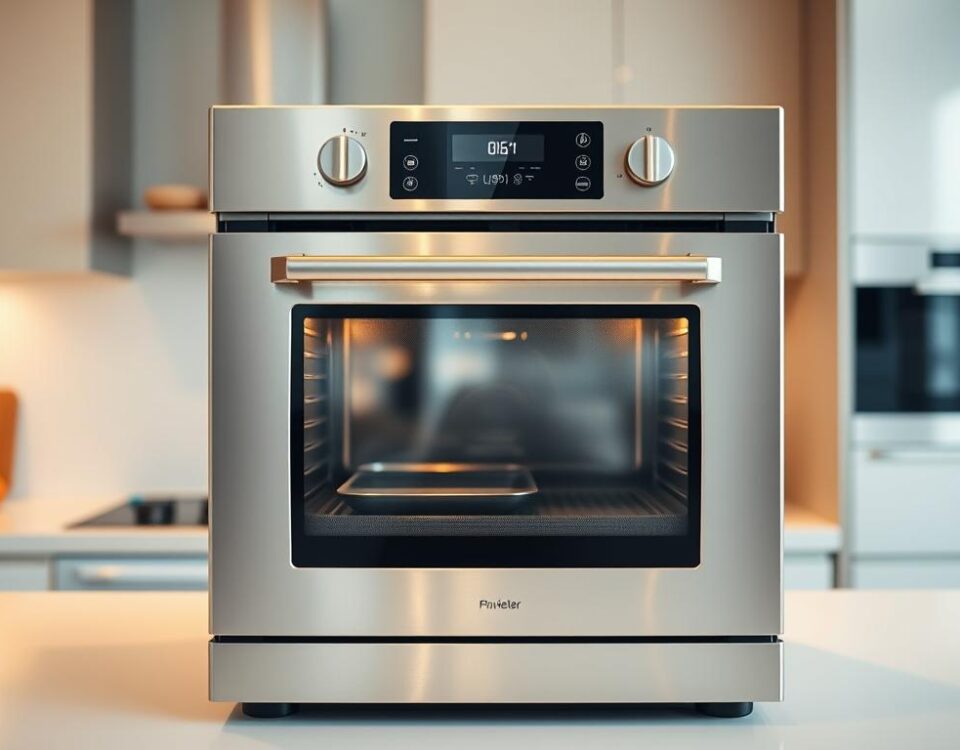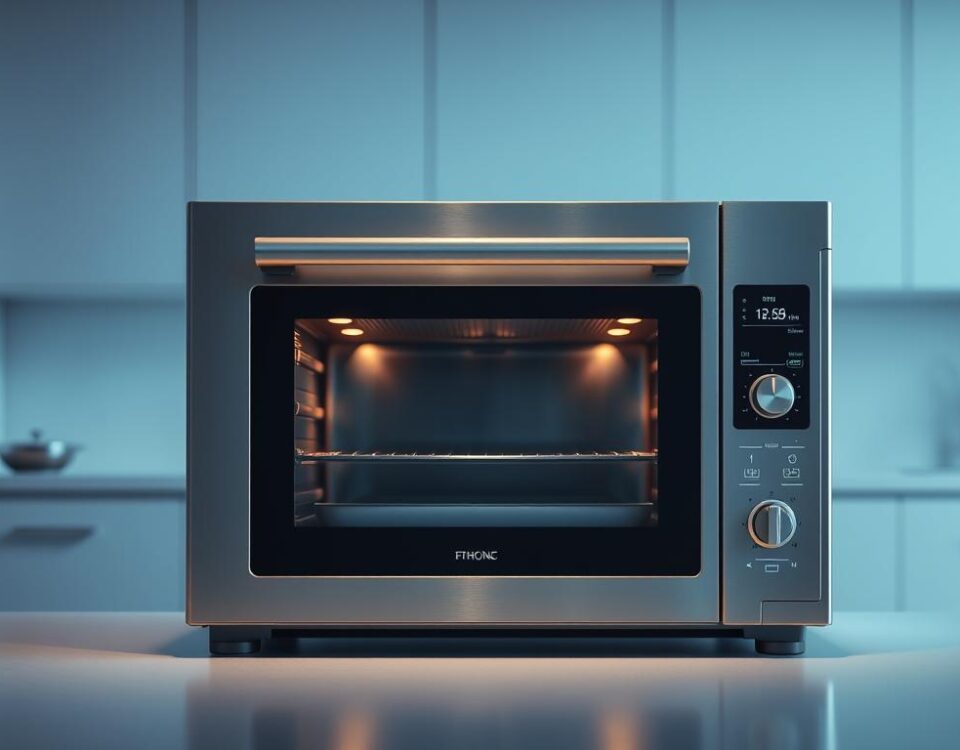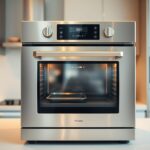
I Baked, Steamed, and Roasted with 4 Combi Ovens—Only One Excelled
September 26, 2025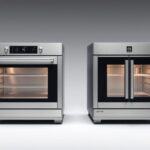
4 Differences Between Rational and UNOX Combi Ovens
September 27, 2025When setting up a commercial kitchen, one of the most crucial decisions is choosing the right equipment, as it affects output, costs, and food quality. I recall a restaurant that struggled with inconsistent cooking results due to inadequate ovens. This experience highlights the importance of selecting the right cooking technology.
Did you know that combi ovens have revolutionized commercial cooking by combining multiple methods in one appliance? With the gas vs. electric debate being a critical consideration, making an informed choice is vital. The right decision can significantly impact your kitchen’s efficiency and bottom line.
So, how do you choose between gas and electric combi ovens to ensure you’re making a profitable choice for your business? The answer lies in understanding your specific operational needs and the benefits of each option.
Key Takeaways
- Understand the key differences between gas and electric combi ovens.
- Consider your menu type and kitchen layout when making a decision.
- Evaluate the upfront investment and long-term operational expenses.
- Assess the cooking performance and temperature precision of each option.
- Consider energy efficiency and maintenance requirements.
Understanding Combi Oven Technology
Combi ovens are redefining cooking technology by integrating convection, steam, and combination cooking modes. This multi-functional approach has transformed commercial kitchens, enabling chefs to prepare a wide range of dishes with precision and consistency.
What Makes Combi Ovens Unique
Combi ovens have several distinct features that set them apart from traditional cooking equipment. They combine convection, steam, and combination cooking in a single unit, allowing for greater flexibility and efficiency in the kitchen.
The benefits of combi ovens include precise temperature and humidity control, programmable recipes, and consistent results. By maintaining optimal moisture levels during cooking, combi ovens help preserve food quality, resulting in less shrinkage and higher yield from ingredients.
These advanced appliances can replace multiple pieces of equipment, such as steamers, convection ovens, and holding cabinets, thereby saving valuable kitchen space and reducing overall equipment investment. With their advanced technology, combi ovens are becoming an indispensable tool in modern commercial kitchens, enhancing cooking performance and kitchen efficiency.
Gas vs Electric Combi Oven: Core Differences
Gas and electric combi ovens have distinct characteristics that impact cooking results, making it essential to understand these differences. The primary distinction lies in their heat generation and distribution mechanisms, which significantly affects cooking performance.
Heat Distribution and Cooking Performance
The heat distribution mechanism is a critical factor in cooking performance. Gas combi ovens provide an immediate heat response with an open flame, allowing for quick temperature adjustments that many chefs prefer for precise cooking control. On the other hand, electric combi ovens typically offer more consistent and even heat distribution throughout the cooking chamber, which can be advantageous for baking applications.
Key differences in heat distribution:
- Gas models offer immediate heat response
- Electric models provide consistent heat distribution
- Cooking results vary based on heat distribution mechanisms
Temperature Control and Precision
Temperature control is another crucial aspect where gas and electric combi ovens differ. While electric kitchen appliances can provide more exact temperatures, they are slower to adjust to temperature control changes. Gas appliances, on the other hand, offer more flexible temperature control, allowing chefs to make quick changes as needed.
As noted by experts, “The controls on a gas appliance directly affect the flow of natural gas, enabling chefs to make rapid temperature adjustments.” This flexibility is particularly valuable in fast-paced kitchen environments.
The choice between gas and electric ultimately depends on your specific cooking needs and preferences.
Initial Investment Considerations
When considering a combi oven for your kitchen, the initial investment goes beyond just the purchase price. It’s essential to evaluate both the upfront costs and the long-term expenses to make an informed decision.
Purchase and Installation Costs
The purchase price of a combi oven can vary significantly depending on whether you choose a gas or electric model. Generally, electric combi ovens have a lower initial equipment cost compared to their gas counterparts. However, the total cost of ownership is also influenced by installation expenses. For gas combi ovens, this includes the cost of connecting to a gas line, which can be more complex and expensive, especially if your kitchen’s infrastructure isn’t already set up for gas equipment. On the other hand, electric combi ovens might require upgrades to your electrical panel or additional wiring, adding to the overall cost.
Space and Infrastructure Requirements
Both gas and electric combi ovens have specific space and infrastructure requirements that can impact your kitchen’s layout and operational efficiency. Gas combi ovens, for instance, require more complex ventilation systems and hood requirements, which can significantly increase installation costs. Additionally, the physical dimensions and utility connection requirements of the combi oven you choose can influence your decision, especially in kitchens with limited space or existing utility constraints.
It’s crucial to assess your kitchen’s existing infrastructure, including gas lines and electrical capacity, to determine which type of combi oven is more economical for your specific situation.
Long-Term Operational Expenses
The true cost of owning a combi oven extends far beyond the initial investment. To make an informed decision, it’s crucial to consider the long-term operational expenses associated with both gas and electric models.
Energy Efficiency and Utility Costs
When evaluating combi ovens, energy efficiency is a critical factor in determining long-term operational costs. Gas combi ovens generally offer lower energy costs compared to their electric counterparts, particularly in regions where natural gas is readily available and priced competitively. The cost of electricity versus natural gas varies significantly across different regions in the United States. For instance, on the West Coast, electricity can be up to 7 times more expensive than natural gas per million BTUs, while on the East Coast, this ratio is around 4 to 1.
| Region | Electricity Cost (per million BTUs) | Natural Gas Cost (per million BTUs) |
|---|---|---|
| West Coast | $70 | $10 |
| East Coast | $40 | $10 |
Maintenance and Repair Expenses
In addition to energy costs, maintenance and repair expenses play a significant role in the overall cost of ownership. Gas combi ovens tend to have fewer electronic components that can fail, but they require regular maintenance of burners and gas lines. On the other hand, electric combi ovens often have more complex control systems that may necessitate specialized technician service when issues arise.

By understanding these factors and calculating your total cost of ownership over a 5-10 year period, you can make a more informed decision about whether a gas or electric combi oven is the most profitable choice for your business.
Kitchen-Specific Factors to Consider
Kitchen-specific factors are pivotal in making a profitable choice between gas and electric combi ovens. The type of menu you offer, your kitchen’s layout, and your staff’s adaptability all play crucial roles in this decision.
Menu Type and Cooking Requirements
Your menu items and cooking techniques should significantly influence your choice between gas and electric combi ovens. Certain foods benefit from the specific heating characteristics of either gas or electric models. For instance, baked goods often fare better in electric ovens, while proteins that require flame-searing are more suited to gas ovens. Understanding these nuances is key to maximizing your kitchen’s efficiency and food quality.
- Evaluate how your menu items align with the strengths of gas or electric combi ovens.
- Consider the cooking techniques required for your menu and how they match up with the capabilities of gas or electric models.
Kitchen Layout and Ventilation
The layout of your kitchen and its ventilation system are critical factors in choosing between gas and electric combi ovens. Gas ovens require more robust ventilation systems compared to their electric counterparts, which can impact your kitchen’s design or renovation plans. A well-designed kitchen layout can enhance workflow and efficiency, particularly during peak service periods.
- Assess your kitchen’s existing ventilation system and its capacity to accommodate a gas combi oven.
- Consider how the installation of a combi oven might necessitate changes to your kitchen’s layout or ventilation infrastructure.
Staff Training and Adaptation
The ease with which your staff can adapt to combi oven technology is another vital consideration. While modern combi ovens are designed to be user-friendly, staff experience and preferences can influence the transition. Programmable features can simplify training and ensure consistency across different skill levels. Investing in staff training can maximize the benefits of your combi oven investment.
- Evaluate your staff’s experience with combi ovens and their ability to adapt to new technology.
- Leverage the programmable features of modern combi ovens to streamline staff training and enhance cooking consistency.
Key Benefits of Modern Combi Ovens
The latest combi ovens offer a multitude of benefits that can enhance kitchen operations and food quality. These advanced appliances are designed to provide precise temperature and moisture control, allowing for maximum customization in cooking.
Programmable Menus and Cooking Modes
Modern combi ovens feature programmable menus and cooking modes that enable users to store hundreds of recipes with precise settings for temperature, time, and humidity. This feature ensures consistent food quality regardless of the staff member operating the equipment, reducing training requirements and improving operational efficiency.
With programmable menus, complicated recipes that require steam or convection settings can be simplified, making it easier to achieve consistent results. Both gas and electric models offer these advanced features, although their implementation may vary slightly between manufacturers and models.
Food Quality and Yield Improvements
Combi ovens improve food yield through better moisture retention during cooking, resulting in less product shrinkage and higher profit margins. The use of steam and convection helps preserve flavors and nutrients in recipes, leading to a better-quality product. This is particularly beneficial for cooking meats, as steam keeps them moistened and prevents shrinkage.
The combination of cooking modes in combi ovens allows for overnight cooking and holding capabilities, extending the kitchen’s productive hours without additional labor costs.
Labor Savings and Operational Efficiency
The multi-functionality of combi ovens streamlines kitchen operations by replacing multiple pieces of equipment, reducing kitchen footprint and simplifying workflow. The precise controls in modern combi ovens enable exact replication of cooking results, ensuring consistent food quality that customers can rely on.
By reducing the need for multiple appliances and simplifying cooking processes, combi ovens contribute to labor savings and operational efficiency in commercial kitchens.
Making the Profitable Choice for Your Business
Choosing between a gas and electric combi oven is a critical decision that impacts your kitchen’s efficiency and profitability. To make an informed choice, it’s essential to consider several key factors, including initial costs, operational expenses, cooking performance, and kitchen-specific considerations.
A combi oven is a versatile unit that can replace multiple pieces of equipment, such as a steamer, convection oven, proofer, or holding cabinet. Although the initial investment in a combi oven is higher than for any single piece of equipment, it’s still a cost-effective solution in the long run.
To determine the most profitable option, I recommend conducting a total cost of ownership analysis. This involves factoring in the purchase price, installation costs, utility expenses, maintenance, and the expected lifespan of the oven. It’s also crucial to weigh the importance of different factors based on your business model, menu requirements, and growth plans.
Consulting with equipment specialists and chefs who have experience with both gas and electric models can provide valuable insights. Additionally, considering future trends in energy costs, environmental regulations, and kitchen technology will help you make a decision that remains profitable in the long term.
Ultimately, the most profitable choice between a gas and electric combi oven depends on your specific operational needs, existing kitchen infrastructure, and business objectives.
FAQ
What is the primary difference between a combi oven that uses natural gas and one that is electric?
The main difference lies in their heating elements and energy sources. A natural gas combi oven uses a gas line to produce heat, while an electric combi oven relies on electricity. This affects their temperature control, cooking performance, and operational costs.
How do I determine whether a combi oven is suitable for my kitchen’s cooking needs?
To decide, consider your menu type, cooking requirements, and kitchen layout. If you need to cook a variety of dishes, including baking and roasting, a combi oven is a great choice. Assess your kitchen’s ventilation system and available space to ensure compatibility.
What are the benefits of precise temperature control in a combi oven?
Precise temperature control allows for consistent cooking results, reduced food waste, and improved food quality. It also enables chefs to cook a wide range of dishes with confidence, from delicate baking to high-heat cooking.
How do I maintain my combi oven to ensure optimal performance and longevity?
Regular maintenance is crucial. Clean the oven regularly, check and replace worn-out parts, and have a professional inspect the appliance annually. This will help prevent breakdowns, reduce energy consumption, and maintain cooking performance.
Can I install a combi oven in any kitchen, regardless of its size or layout?
While combi ovens are versatile, their installation requires careful consideration of kitchen layout and ventilation. Ensure you have sufficient space, a compatible hood, and adequate ventilation to remove excess moisture and heat.
Are there any specific safety concerns when using a combi oven?
As with any kitchen appliance, follow the manufacturer’s instructions and take necessary safety precautions. Ensure proper installation, maintain a clean and clear workspace, and train staff on safe operation and emergency procedures.
